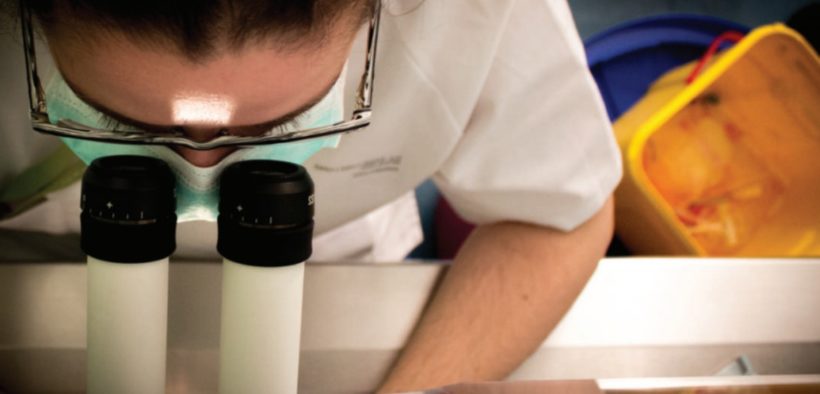Cancer Assassins

Customized cancer vaccines that trigger the immune system to react only to one’s specific tumours are the need of the hour. Here are two companies collaborating to make this a reality
By Rosy Jose
The biggest flaw with existing therapies for cancer is that they are not able to recognise the difference between cancerous and non-cancerous cells. This is because cancer cells develop out of mutations in healthy cells and are able to mask their presence as foreign bodies from the immune system. Current treatment therapies tend to compromise healthy cells adjacent to the cancer cells, and weaken the already jeopardised immune system. The need of the hour is a treatment methodology that can seek out and kill only cancer cells, leaving the healthy cells intact. The answer to this conundrum is being developed by two collaborating pioneers in the biotechnological and genetic research space—Genentech Inc., USA (a subsidiary of Roche Pharmaceuticals), and BioNTech (a German biotechnology company). The partnership combines Genentech’s cancer immunotherapy research portfolio and diagnostic, manufacturing and commercial competence with BioNTech’s proprietary mRNA cancer vaccine technology platform (IVAC® Mutanome) and personalised medicine expertise. Together they have developed a customised cancer vaccine—a vaccine precisely tailored to trigger the immune system to react to one’s specific tumours.

Current treatment therapies tend to compromise healthy cells adjacent to the cancer cells, and weaken the already jeopardised immune system. The need of the hour is a treatment methodology that can seek out and kill only cancer cells, leaving the healthy cells intact.
How it works
Each cell has several different glycoproteins protruding from its surface called Histocompatibility Complex (HLA). Just like a fingerprint, the HLA complex is unique in every person. This protein structure helps the immune system differentiate itself from foreign bodies and hence, is responsible for the regulation of the immune system. Cancerous cells, however, showcase only a few proteins (Neoantigens or Neoepitopes) that are different on their cellular surfaces. These can be used by the immune system to recognise them as foreign and launch an attack against them. The challenge is to select those proteins that can be easily detected BUYMYHOUSE7, rather than those hidden in grooves of the HLA.
To understand which of these proteins are specifically expressed on only the cancerous cells, samples of both the tumour tissue (after biopsy) and healthy tissue are collected and sent to the lab for genome sequencing (Mutanome vs Genome). A complex algorithm is used to identify the ten mutations that are most likely to be perceived by the immune system as foreign. This is because tumours are heterogeneous (various clones with different genetic makeups). If the focus is only on one mutation, there’s a risk that the immune system will not be primed to attack all the clones. These ten mutations are divided between two m-RNA (messenger Ribonucleic acid) molecules, synthesised in-vitro and constituted into individualised cancer vaccines.
The vaccine is then administered to the recipient along with checkpoint inhibitors. The rationale behind it is that while the m-RNA code guides the immune system to step up their attack on targeted cancer cells, the checkpoint inhibitors helps elicit a stronger response.
see more at https://reform7-catalog-knowledge.apps.dfy.buddyboss.com/how-to-put-xbox-series-s-in-sleep-mode/
Business Implication
Though this treatment modality is a remarkable medical breakthrough, it is facing the most familiar operational challenge of any business model: how to control manufacturing costs and logistics hurdles. This is definitely not a product that can follow the path of established manufacturing processes, and packaging, sales and distribution channels. This may require companies to embrace an entirely new and untested business model. For a product like this, time is of the essence and these vaccines typically take a few weeks to make. The first hurdle is scaling up production. To create this drug, the company would have to orchestrate a multi-step process for each patient which is fast and efficient with quality checks in place (to prevent contamination). An option would be to facilitate the process at multiple sites to cater for the large demand and reduce time required for transportation. Realising this dream will need a multifaceted work force that would not only include research technicians but also supply-chain specialists, regulatory experts and diagnosticians alike. If done right, the extra costs involved and thinner profit margins will be offset by the sheer volume of people availing treatment.
The Human Genome project spurred interest in DNA sequencing, which resulted in the discovery of cheap genetic sequencing methods. However, though the production of the RNA vaccine is much easier than that of proteins or antibodies, since the technology is still at its nascent stages, costs are high. Future Plans BioNTech has been able to automate some processes and reduce the time of manufacturing from three months to around six weeks per vaccine. The challenge is to further reduce the production time to four weeks. The current capability of the company is to cater to a few hundred, however if the vaccine has to be market ready, Genentech and BioNTech will need to effectively produce between 10,000 and 20,000 vaccines per year against a broad range of cancers.
Competition
There are other collaborators who are also looking at bringing similar products to the market. Moderna, a biotech company based in Massachusetts, has partnered with the pharmaceutical giant Merck for a vaccine targeting solid tumours. Neon Therapeutics, founded by researchers at Dana Farber Cancer Institute and Washington University, is gearing up to release a similar vaccine derived using a different method. All this proves just one thing: modern science is on road to unlock the paradox that is cancer and develop a cutting edge treatment for it.

















Its a pleasure for me to write this testimony about how i got my Genital Herpes cured a month ago. i have been reading so many comments of some people who were cured from various diseases by Dr .Hazim, but i never believed them. I was hurt and depressed so I was too curious and wanted to try Dr. Hazim , then i contacted him through his email when i contact him, he assured me 100% that he will heal me, i pleaded with him to help me out. My treatment was a great success, he healed me just as he promised. he sent me his medication and ask me to go for check up after 21 days of taking the medication. i agreed with him i took this medication and went for check up after 21 days of the treatment, To my greatest surprise my result came out negative after the treatment, I’m very happy that i was cured and been healthy again. I waited for 3 weeks to be very sure if I was completely healed before writing this testimony. I did another blood test one week ago and it was still Herpes negative. so i guess its time i recommend anyone going through Herpes, HSV-1 or HSV-2, HIV, HPV, Hepatitis B, Diabetes, Cancer to contact this great man through his Email [email protected] OR add him up on whatsApp +2349058026857